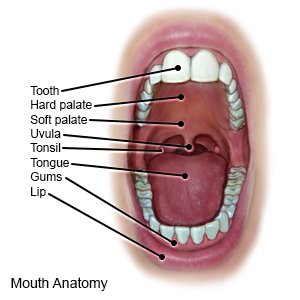Dental Laceration
Medically reviewed by Drugs.com. Last updated on Apr 6, 2025.
A dental laceration is a cut, gash, or tear in the soft tissue around your teeth. This can include your tongue, gums, lips, or the inside of your cheeks. Trauma is the most common cause of a dental laceration. Some examples include a car accident, a fall, or a sports injury.
 |
DISCHARGE INSTRUCTIONS:
Return to the emergency department if:
- You have heavy bleeding or bleeding that does not stop after 10 minutes of holding firm, direct pressure over the wound.
- Your stitches come apart.
- You have sudden numbness in your face.
- You have severe pain.
- You cannot move part of your face.
Call your doctor or dentist if:
- You have a fever or chills.
- You have increased swelling, redness, or bleeding.
- You have yellow or green drainage coming out of the laceration.
- You have pain that does not go away or is not helped by pain medicines.
- You have trouble opening your mouth or chewing.
- You have questions or concerns about your condition or care.
Medicines:
You may need any of the following:
- Antibiotics help treat or prevent an infection caused by bacteria.
- Acetaminophen decreases pain and fever. It is available without a doctor's order. Ask how much to take and how often to take it. Follow directions. Read the labels of all other medicines you are using to see if they also contain acetaminophen, or ask your doctor or pharmacist. Acetaminophen can cause liver damage if not taken correctly.
- NSAIDs , such as ibuprofen, help decrease swelling, pain, and fever. This medicine is available with or without a doctor's order. NSAIDs can cause stomach bleeding or kidney problems in certain people. If you take blood thinner medicine, always ask if NSAIDs are safe for you. Always read the medicine label and follow directions. Do not give these medicines to children younger than 6 months without direction from a healthcare provider.
- Prescription pain medicine may be given. Ask your healthcare provider how to take this medicine safely. Some prescription pain medicines contain acetaminophen. Do not take other medicines that contain acetaminophen without talking to your healthcare provider. Too much acetaminophen may cause liver damage. Prescription pain medicine may cause constipation. Ask your healthcare provider how to prevent or treat constipation.
- Take your medicine as directed. Contact your healthcare provider if you think your medicine is not helping or if you have side effects. Tell your provider if you are allergic to any medicine. Keep a list of the medicines, vitamins, and herbs you take. Include the amounts, and when and why you take them. Bring the list or the pill bottles to follow-up visits. Carry your medicine list with you in case of an emergency.
Self-care:
- Care for your mouth while you heal. Use a soft toothbrush. Rinse your mouth as directed. Your healthcare provider may recommend a solution that contains chlorhexidine 0.1%. This solution will help prevent an infection caused by bacteria. Rinse 2 times each day for 1 week, or as directed.
- Eat soft foods or drink liquids for 1 week or as directed. Soft foods and liquids may be easier to eat until your injury heals. Soft foods include applesauce, pudding, mashed potatoes, gelatin, and ice cream.
- Apply ice to decrease swelling and pain. Apply ice on your jaw or cheek for 15 to 20 minutes every hour or as directed. Use an ice pack, or put crushed ice in a plastic bag. Cover the bag with a towel before you apply it.
- Keep any soft tissue wounds clean. Use prescribed mouthwash as directed. You can also gargle with a salt water solution. To make the solution, mix 1 teaspoon of salt and 1 cup of warm water. Ask your provider for more information on how to clean your wounds.
Follow up with your dentist or oral surgeon as directed:
You may need to return to have your stitches removed. You may be referred to a specialist for more tests or treatment. Write down your questions so you remember to ask them during your visits.
© Copyright Merative 2025 Information is for End User's use only and may not be sold, redistributed or otherwise used for commercial purposes.
The above information is an educational aid only. It is not intended as medical advice for individual conditions or treatments. Talk to your doctor, nurse or pharmacist before following any medical regimen to see if it is safe and effective for you.
Further information
Always consult your healthcare provider to ensure the information displayed on this page applies to your personal circumstances.
